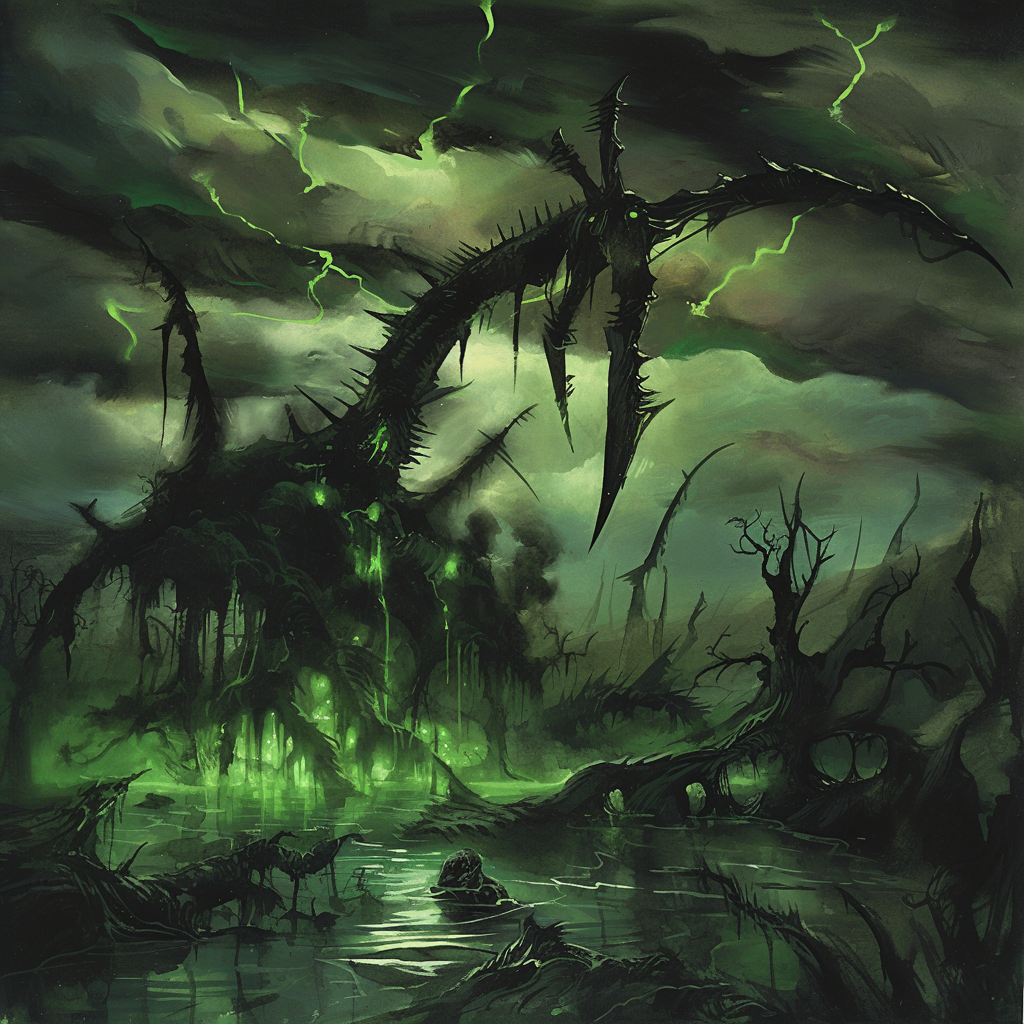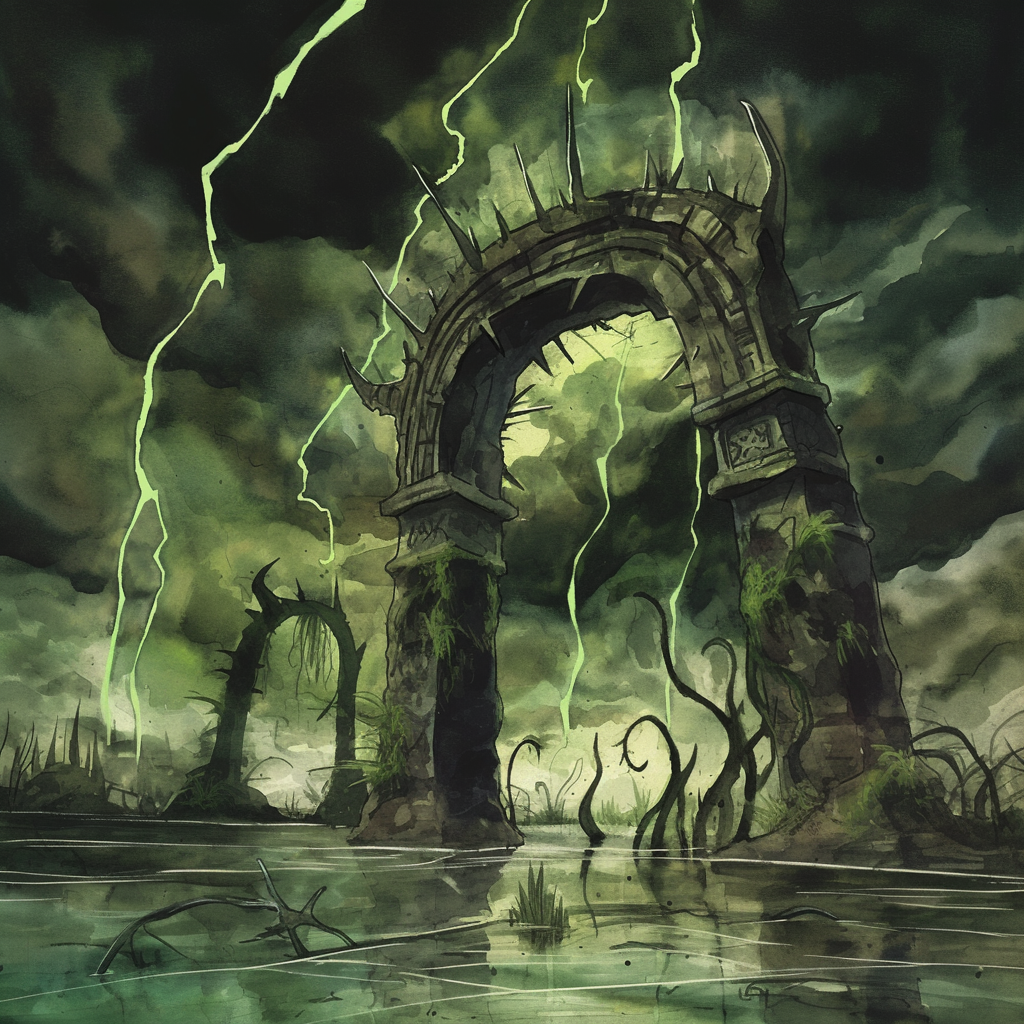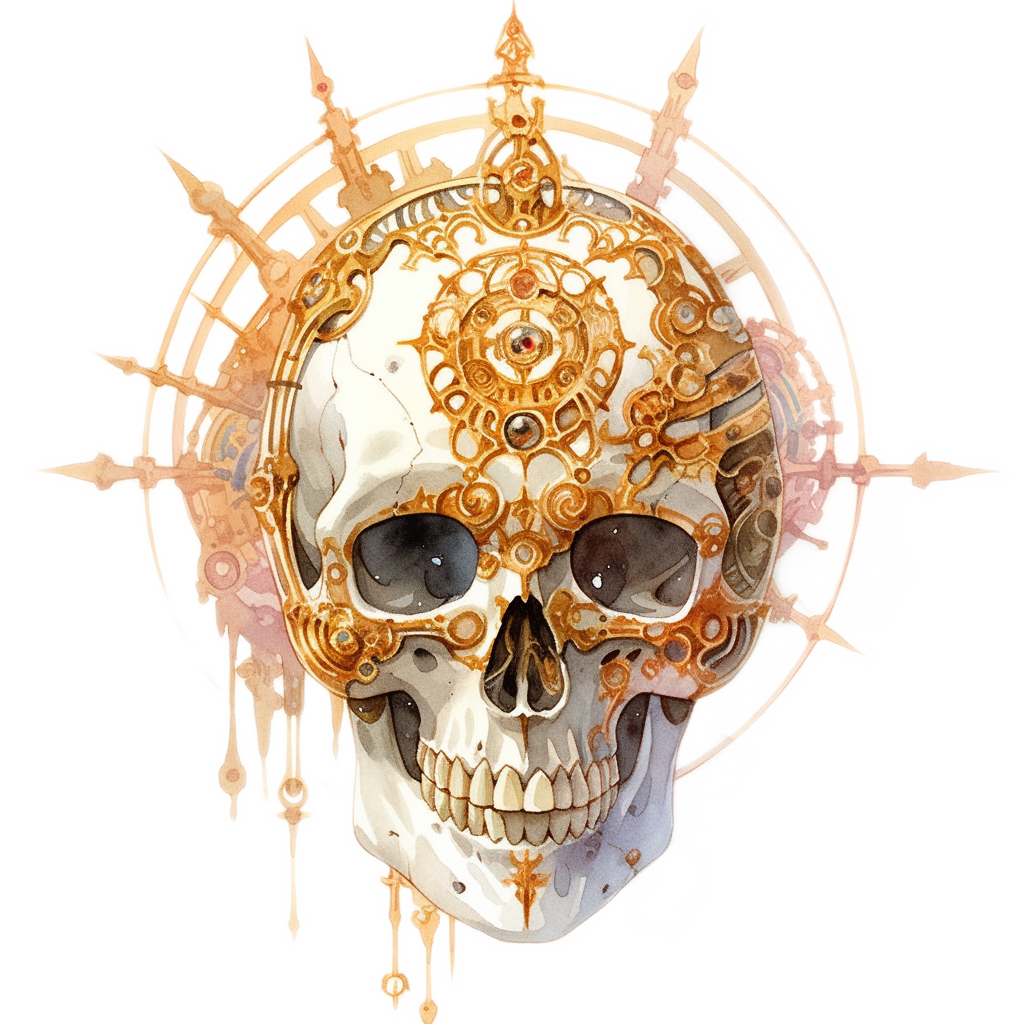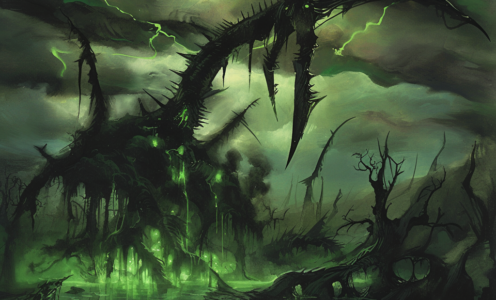A Brief History of Kearackinin

Ah, little hatchlings, you are back again asking to hear more of the Old Stories? Then sit close, for the mists tonight carry whispers of what once wasss. This is the story our people tell of Kearackinin before the gates were sealed, of why our minds-eyes turned inward, why our songs are heavy with sorrow. Then hear me, for this tale is not one of triumph, but of betrayal and despair. It is the story of how the Blood War came to Kearackinin and how it nearly broke our people. It is a tale of pride, betrayal, and of punishment—of how our god-king Sess’innek saved us from ruin.
Long ago, before the Phantom Plane was hidden from the multiverse, it was a place of boundless vitality. The swamps teemed with life—great beasts that towered over trees, rivers that glowed with emerald light, and skies where storms danced like wild spirits. Sess’innek shaped this land to mirror his philosophy: A realm where strength ruled supreme and only the cunning survived.
The Betrayal
Remember this hatchlings: The Abyss is a place of endless war, where the tanar’ri demons rate armies to fight their eternal foes, the baatezu devils. This war—the Blood War—spills across countless planes, and in time, the tanar’ri came to the sacred swamp.
The tanar’ri saw our people not as allies but as tools. The demons whispered lies into the ears of our chieftains, promising power and glory if we fought alongside them, against the hated devils. Many believed these blood lies; they saw war as a chance to prove their strength. But what did the tanar’ri care for us? To them, our people were nothing more than expendable cold-blooded pawns.
When our warriors fell in battle, they did not find rest in Sess’innek’s tight embrace. No hatchlings! The tanar’ri stole their souls—twisting them into grotesque forms to serve again as slaves in their endless war; slavering dretches, hulking hezrou. Our proud kin were reduced to mindless beasts, their scales blackened by Abyssal fire, their wills broken by the fetters and the lash.
The tanar’ri used us as cannon fodder against the infernal legions. They forced wave after wave of our kin to die on accursed battlefields, caring nothing for the eternal loss of their souls on foreign planes. Even those who survived were scarred beyond recognition—hollowed out by the horrors they had seen and done.
Yes, the Blood War left deep wounds upon our people hatchlings. Those few who returned to Kearackinin were no longer whole. They spoke of cruelties beyond imagining—of how the tanar’ri treated them as thralls, forcing them to fight battles that were not theirs to fight. They grew bitter and inward-looking, distrusting all who came from beyond our swamps. Even among ourselves, suspicion festered like a wound. Who could say whether a neighbour had been corrupted by the tanar’ri’s lies? Who could trust anyone when betrayal had become so familiar?
The Sealing of the Gates

Sess’innek saw what was happening to his people—their pride shattered, their unity broken by the Blood War’s poison. He saw how even his cheiftains began to falter under the weight of despair. And he saw how the Blood War itself was beginning to spill into Kearackinin. And so he acted.
With his six mighty arms raised high, Sess’innek unleashed divine wrath upon the gates that connected Kearackinin to Pazunia and the Grand Abyss and other layers. He sealed them all with ancient magicks so eldritch that even the mightiest demon lords could not break through. By doing so, he ended the exploitation of our ancestors—but he also cut them off from the rest of existence.
At first, our ancestors rejoiced in their isolation. No longer would outsiders come to plunder the riches of the plane; no longer would our ancestors be dragged into wars that were not theirs to fight. But over time, they began to feel the weight of exile.
And hatchlings, Kearackinin grew darker in its solitude. The swamp itself mourned—its waters turned stagnant and poisonous, its skies grew heavy with storm clouds that never broke. Our ancestors became insular and mistrustful, clinging desperately to what little they had left. Many of those broken by the Blood War went barmy, and retreated deep into the swamps to become monsters.
Our people realised that Kearackinin’s sealing was also a punishment by Sess’innek—a warning not to stray too far from his teachings. Our ancestors found strength in civilisation, grouping together in protective burgs and bastions, drawing in further from the dangers of the swamp. Sess’innek tested the most mighty and ambitious of his people, and from their numbers emerged his chosen few. These few were transformed into glorious Lizard Kings in the secret part of the layer called Breeding Grounds.
And so our ancestors live on in the sealed realm, under Sess’innek’s eye. Some say he protects them from enemies who would destroy them; others believe he tests them endlessly to ensure they remain worthy of his favour. Perhaps he means for them to suffer in the prison-swamp until our ancestors prove themselves worthy once more.
Do not seek to undo what has been done, little hatchlings. The gates are sealed for a reason—and those who try to open them will find only ruin. Now go! Take these stories with you into your dreams…but sleep lightly.
Editor’s note: You’ll have detected a strong apologist bias to this account, I am sure. The sparse chant I have gathered from other sources suggest Sess’innek is gaslighting his petitioners, forcing them to live in terrible conditions to extract maximum loyalty and fear from them. Of course, no rational khaasta would worship a being like this so it’s understandable that the official stories of the khaasta’s shaman cast the situation in a more sympathetic light, with Sess’innek as a protector-saviour and the outsiders as the enemy. Cut off from the planes, however, Kearackinin is stagnating and being slowly corrupted by the unfettered wickedness of the Abyss itself.
See Also: The Gates Hermetic, being an exploration of what it means to seal a layer
Canonical Reference: Planes of Chaos Abyss Poster [2e] (brief layer description)
Source: Jon Winter-Holt


